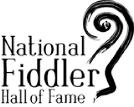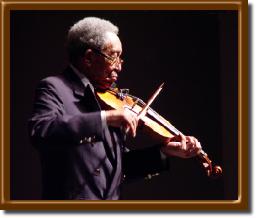|
|
|
|
|
|
|
|
|

Claude "Fiddler" Williams
The National Fiddler Hall of Fame
|
Claude "Fiddler" Williams
YouTube - (Link)
Excerpted and edited from Progressive CD liner notes, 1995
It has taken over 75 years for the violin style heard on this disc to evolve. Claude Williams was swinging on stringed instruments before the word "jazz" had been applied to music. Born in Muskogee, Oklahoma, in 1908, Williams played guitar, mandolin, banjo and cello by the age of ten. He then heard Joe Venuti's violin at an outdoor pavilion "above the orchestra, on top of all the other instruments" and convinced his family to buy him his first fiddle the next day.
By the time he went to bed that night, he was playing the third song on this CD, "You've Got To See Mamma Ev'ry Night (Or You Can't See Mama At All)" on his violin. His paying work started with his brother-in-law Ben Johnson's string band, a group of young musicians playing barber shops, hotels, and front yards. Claude remembers making good tip money in an evening, "six to seven dollars apiece ... and folks were working all week for five to six dollars then." The Pettiford Family Band, with young Oscar Pettiford, was the first of many "territory" bands to feature Claude.
Williams moved to Kansas City in 1928 when it was a hot-bed for swing, the new popular music of the era. Claude insists the best musicians could only make it big after a K. C. trial, saying they "had to earn their Kansas City Stamp, then they could go anywhere." Kansas City was wide open with good musicians finding plenty of work in an active club scene, even during prohibition. Claude's first recordings were made in 1928 on guitar and violin with the Twelve Clouds of Joy for the Brunswick label. This band was first led by Terrence Holder, then by Andy Kirk, and included the great Mary Lou Williams arranging and composing at the piano. When the band needed to add more tunes to play at jitney dances, Claude developed and played horn arrangements that Mary Lou wrote out for her husband John Williams to play.
In 1930 the Twelve Clouds of Joy with Claude made a New York debut playing the Roseland Ballroom and Harlem's Savoy. The band returned to K.C. where many clubs near 18th and Vine were employing bands. Battles of the bands, jam sessions and cutting contests occurred around the clock. In those situations, horn players such as Lester Young, Ben Webster, Hershel Evans and Buddy Tate had a major influence on Claude's style. Fiddler either battled or was a member of the best bands in Kansas City -- he joined Alphonso Trent's band and George E. Lee's Orchestra before leaving the area temporarily.
Count Basie searched for the great guitarist and fiddler he remembered from Kansas City when assembling his first big band in 1936. Basie found Claude in Chicago, where he had been playing with Eddie Cole's band. Eddie's brother, Nat "King" Cole, played in that band. Williams said "Nat didn't even know he could sing then, but he was the best piano player in Chicago". As part of the Count Basie Orchestra, Claude Williams briefly enjoyed national fame. He was voted "Best Guitarist of The Year" in a Downbeat national reader's poll. Claude now thanks Freddie Green for replacing him on guitar in the Basie Orchestra, saying that, "if I had stayed with Count, I would have just been playing that ching-ching rhythm guitar for forty years."
In the 1940s, Claude worked with a WPA band in Michigan and The Four Shades of Rhythm in Chicago. He once played on the Arthur Godfrey Show with Austin Powell's Quintet in New York. Williams began using amplification on his fiddle in 1950. He was with Roy Milton's Blues Band in Los Angeles in 1951 and 1952. In 1953, Claude moved back to Kansas City to lead his own combo on fiddle and guitar. Saxophone player Eddie "Cleanhead" Vinson was a member of that group. He free-lanced and led bands around Kansas City through the 1960s and did brief stints in Denver and Las Vegas before his return to his Kansas City home in 1969.
Williams toured Europe repeatedly in the 1970s. He worked with pianist Jay McShann, with whom he recorded "The Man From Muskogee" in 1972 for Sackville in Toronto along with Don Thompson on bass and Paul Gunther on drums. It is to be released as a CD in 1995. SteepleChase Records recorded "Call For The Fiddler" with Horace Parlan on piano, Lars Blach on guitar, Hugo Rasmussen on bass and Hans Nymand on drums in Copenhagen in 1976.
In 1980, Classic Jazz released "Fiddler's Dream" with Jay McShann and Andre Persiany alternating on piano, Gus Johnson on drums and Gene Ramey on bass. This was the last recording to feature Claude's guitar work. Since then, he has stayed exclusively with the violin. "Claude Williams' Kansas City Giants" was made with Frank Smith on piano, Gerry Leonard on bass and Richard Ross providing drum and vocal work. "Giants" was released on Big Bear in England in 1980. The Frankfurt Swing All Stars recorded "Jive At Five" in 1988 in Germany with Fiddler fronting the band for Bellaphon (CDLR 40025).
"Claude Williams Live at J's, Parts 1 and 2," (Arhoolie CD 405 and CD 406), arguably considered his best recordings at the time, were recorded in 1989 in New York and released in 1993. Ron Mathews is on piano, Al McKibbon on bass, James Chirillo on guitar and Akira Tana alternates with Grady Tate on drums. Mathews, McKibbon and Tate were working with Claude in "Black and Blue" at the time of this recording. "Black and Blue" was conceived as a revue of original Black American art forms for presentation in Paris with Fiddler in its orchestra. It moved to Broadway, played for several years and earned Tony awards. On stage were the very best Black dancers and female vocalists, and behind them a showcase orchestra. Claude Williams had seniority in that eighteen member unit, which included Sir Roland Hanna, Bill Easley and Earl May substituting on bass.
Claude Williams tries to perform music that anyone can enjoy. As he says, he doesn't like to "play music over people's heads." While everything he plays contains his own inventions, he always winds his way back to the basic melodies. The result is music so friendly and engaging that folk audiences have come to appreciate him. The National Council for the Traditional Arts featured Claude in "Masters of the Folk Violin" multi-city tours in 1989, 1994 and 1995. In May of 1994 he made his first journey to Australia as part of a "Living Traditions" tour and a "Violin Summit" in connection with the Brisbane Biennial Festival. Media there described him as "the last of the great swing fiddlers" and "the last great Black jazz violinist."
Claude's Oklahoma roots were acknowledged in 1989 when he was one of the first to be inducted into the Oklahoma Jazz Hall of Fame. In 1994 he accepted the first and only Charlie Christian Jazz Award from Black Liberated Arts, Inc., in Oklahoma City. Williams was born in Oklahoma, but he and his wife Blanche have long considered Kansas City, Missouri, to be home. In October of 1993 he joined members of K. C.'s Charlie Parker Foundation on a special S. S. Norway cruise dedicated to Dizzy Gillespie. His band on that cruise included Earl May and Joe Ascione.
Mr. Williams still worked his territory with regular visits to the internationally acclaimed blues center, The Zoo Bar in Lincoln, Nebraska. National Public Radio's JazzSet featured Claude, Jim Cidlik's vocals and keyboards and Steve Hanson's guitar work at the Zoo on NPR in November of 1994.
Along with release of this CD, 1995 will bring more honors and diverse performances for Claude. Amherst University presented him with its Distinguished Achievement Award, as it has to Max Roach, Dorothy Donegan and others.
Claude "Fiddler" Williams passed away April 25, 2004.
Claude "Fiddler" Williams was inducted into The National Fiddler Hall of Fame in 2008.

